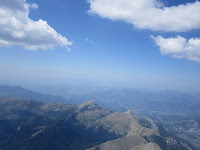I'm going through a bit of a flying gear overhaul. It's been more prolonged and involved than I expected (and I still haven't got to the wing).
It started with a lightweight pod harness. But things spread from there. The harness has a really small primitive cockpit. So my clunky GPS and vario got replaced with a single, sophisticated GPS-vario. But that wasn't the end of things; my lightweight reserve was too big for the harness reserve container; so an even smaller reserve was needed.
There is a lot to like with these changes; lighter gear and better in-flight performance. But it isn't all positive. The gear is more fragile and needs a lot more attention - I still haven't worked out where to put a hook knife. And a bad landing is never a good idea, but (with the lack of back protection) it wouldn't be good for me or (with the lightweight materials) my gear.
Flying a pod - the Advanced Lightness - has pluses and minuses. Most of them are expected - e.g. weightshift is reduced, it's warmer, I'm sure it glides better. But some weren't. For example, my pod starts shaking as I approach a strong thermal from upwind long before my wing or my GPS have told me it's there. Or I get a blast of warm air up my leg when I enter a thermal. Nothing bad, just a little surprising...

My GPS is the Flymaster B1-Nav and it is specially designed for flying. It has a whole set of interesting features - a widget to show you the 'best lift' in your current thermal, something to tell you the wind direction and strength, funky sounds when you get near a thermal. I hope to be convinced of all their benefits soon, but I'm not quite there yet.
But my biggest complaint with the GPS is a little embarrassing. I think the manufacturer should have done a little more analysis of their client-base. Paraglider pilots tend to be, you know, a little older than snowboarders. I can display 6 'custom' fields, but that doesn't mean I can read them. I'd prefer to display 2 or 4 fields that I can easily read.
 Saturday was clearly non flyable and I went a long hike up Cheval Blanc (2300m, 7500 ft). Wonderful mistral weather - cool, windy, sunny - in fact, it was almost too cold. The only things flying wore feathers, and it was impressive watching them; the vultures were still able to make progress to the North (from their colony near Rougon).
Saturday was clearly non flyable and I went a long hike up Cheval Blanc (2300m, 7500 ft). Wonderful mistral weather - cool, windy, sunny - in fact, it was almost too cold. The only things flying wore feathers, and it was impressive watching them; the vultures were still able to make progress to the North (from their colony near Rougon). 







